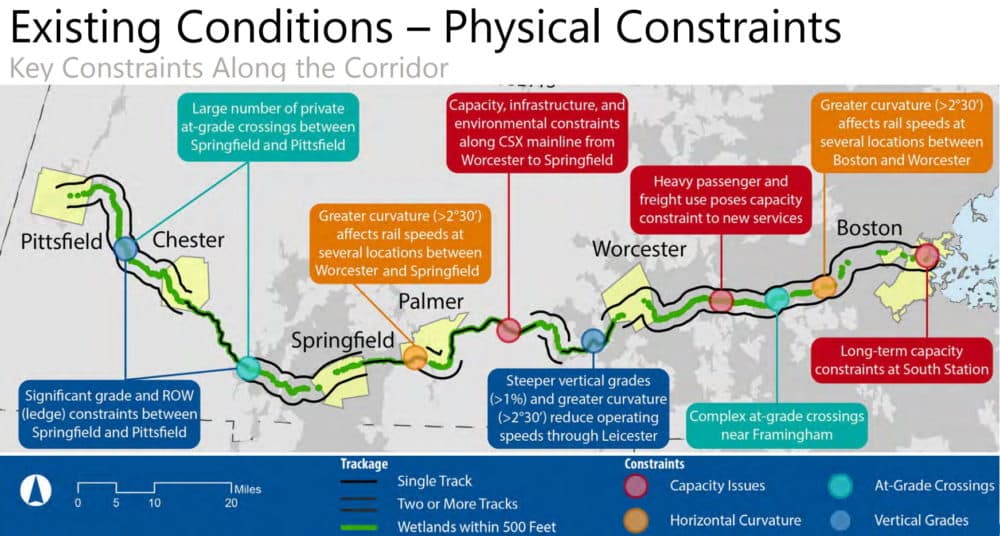Advertisement
High Costs, Few New Riders In Boston-Western Mass. Rail Study

Supporters of a high-speed rail connection between Boston and western Massachusetts have long argued the service would attract scores of riders who are tired of traffic or high housing prices, but a new Department of Transportation study projected an expansion would only draw several hundred new riders per day.
The report from MassDOT estimated that six potential options, ranging from adding a track alongside existing freight lines to building an entire new Boston-to-Pittsfield route, would draw between 36 and 820 new daily boardings at costs ranging from about $2 billion to almost $25 billion.
Travel times also vary widely, with a four-hour trip from Pittsfield to Boston possible under the lowest investment and the same trip possible in two-and-a-quarter hours with the most significant expansion.
The department has been studying a potential commuter rail expansion beyond the current western terminus of Worcester, long sought by advocates and lawmakers from the region, since late 2018. Project officials will present detailed estimates of the costs, ridership, environmental impacts and more on the six alternatives to the East-West Passenger Rail Study Advisory Committee at a Thursday afternoon meeting in Springfield.
On a conference call explaining the report, state Transportation Secretary Stephanie Pollack acknowledged some stakeholders will find those ridership projections lower than expected. She said the numbers — hundreds of new daily riders in 2040 on an expansion to the Worcester Line, which averaged roughly 18,000 trips per day in 2018 — do not assume any population or employment changes as a result of new rail service.
The consultants who drafted the estimates, for example, expect only about 10% of riders to be daily commuters heading to Boston for work.
Supporters, however, have said they believe a viable commuting option from western Massachusetts could attract new residents, reshape the region and offer a more appealing alternative to congested eastern Massachusetts.
Five of the six expansion options have estimated capital prices below $10 billion, significantly less than the most dramatic alternative explored. But Pollack said the numbers are "sobering" because the capital expenses would work out to tens of thousands of dollars per new rider added, several times higher than other projects around the country offered as comparison.
Pollack said "federal funding will clearly be needed" for an east-west rail connection, unlike the $1.05 billion South Coast Rail first phase entirely paid for by the state.
"The costs, particularly for some of the faster alternatives, are sobering and the ridership estimates are lower than some have thought, but we will continue to work with the Advisory Committee," Pollack told reporters.
Right now, passengers have virtually no options for commuting from west of Worcester to Boston on a train other than a single Amtrak train daily, despite tracks already running through Springfield and Pittsfield.
The most extensive option, Alternative 6, would see the state construct all-new track along the Interstate 90 corridor, allowing it to run electric high-speed trains as fast as 150 miles per hour. That option would be costliest, with a projected capital price tag of $24.9 billion, but would also prompt more than twice the growth in ridership as any other option with 820 new commuters per day expected.
Over the next few months, the advisory committee will select three alternatives for additional study to be included in a final report.